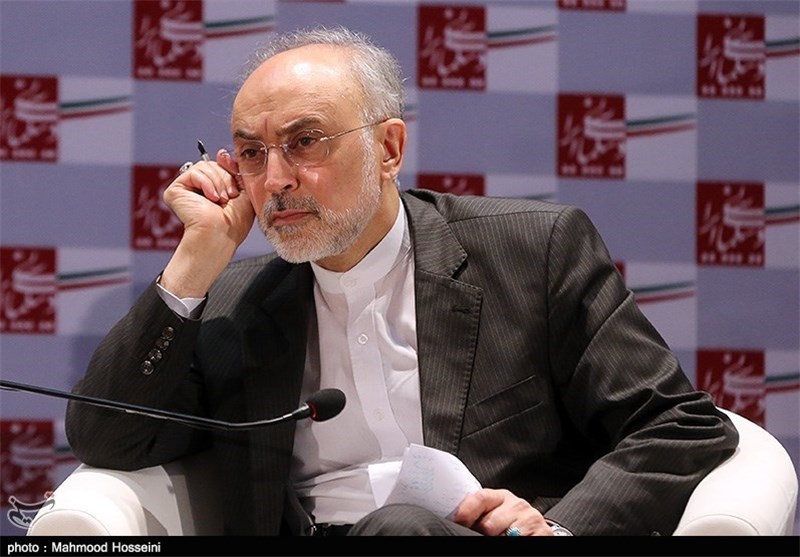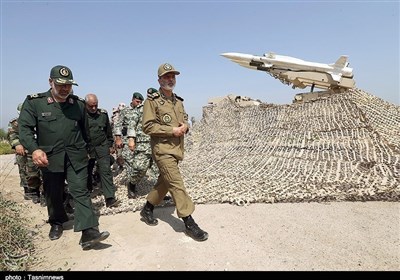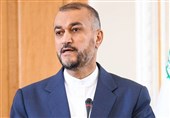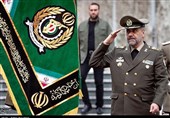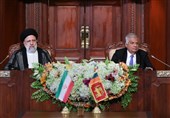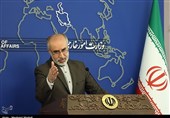AEOI Chief: Iran Plans to Construct 2 More Nuclear Reactors
TEHRAN (Tasnim) – Head of the Atomic Energy Organization of Iran (AEOI) Ali Akbar Salehi said Iran plans to build two more nuclear reactors in addition to the existing Bushehr nuclear power plant.
“…we would be working on different advanced machines. We would be working on the IR8, on the IR6. The IR8 and IR6 are the two candidates that could really meet our needs in terms of producing enough enrichment capacity to meet the annual needs of (the Bushehr power reactor). And 10 years from now, we will have two other nuclear power reactors added to Bushehr. But using (the permitted centrifuges), in 15 years we will be in a position to meet the fuel requirements of these reactors,” Salehi said in an exclusive interview with Science at AEOI headquarters in northern Tehran published on August 12.
Elsewhere in the interview, AEOI chief said that American officials think that they have prevented Iran from moving towards “nonpeacful” activities, stressing that the Islamic Republic of Iran has never been after nuclear weapons due to a Fatwa (religious decree) issued by the country’s Supreme Leader, Ayatollah Seyed Ali Khamenei.
The following is the full text of Science interview with Head of the Atomic Energy Organization of Iran (AEOI) Ali Akbar Salehi:
Q: What stands out as the most memorable moment you spent with secretary Moniz during the negotiations?
A: The first time we met face-to-face, I felt as if we had known each other for so long. One exceptional moment came when I asked Moniz in our last days in Vienna, “Do you have any news about Professor Mujid Kazimi?” He’s a professor of nuclear engineering at MIT. The next day, Moniz comes to me and says, “I have bad news for you.” I thought it’s about the negotiations. I said, “What is it?” He said, “Mujid has passed away.” I said, “My God. Yesterday we were talking about him and you said he’s fine. He’s healthy and he’s doing fine, he’s active.” He said, “Yes. He was in China delivering a scientific talk and then all of a sudden, he has a very strong heart attack and he passes away.” Then I requested Moniz to see if we can get his family’s telephone number. And he found it and gave it to me, and I called the family. I expressed my condolences.
We know each other through all these [mutual] friends. It was very natural for him to look out for his country’s interests. But this did not prevent either of us from being rational. We tried to be logical and fair. We understood each other. I understood his constraints. He understood mine. That’s how we could move forward.
Q: How did you and Moniz end up as negotiating partners?
A: It was about a year and a half that they were negotiating, and they couldn't move forward. In February, I was summoned by my superiors. One of the officials said, "Well, Ali, you have to join the negotiations." I said, "You're joking. What can I do? (Foreign Affairs Minister Mohammad Javad) Zarif has done his best. What more can I do?" There was a long argument. And I said, "Well, politically, if I join the negotiations now and if we fail, then the whole responsibility will be on my shoulders."
But my superiors insisted. I said, "OK, I will go, but on condition that my counterpart also participates." They said, "Who is your counterpart?" I said, "The secretary of the DOE (Department of Energy)." And that was the first time they heard of this department. I said, "If he comes, I will go. If he doesn't come, I will not go." Our side contacted (chief US negotiator) Wendy Sherman, saying "Look, we are intending to bring Mr. Salehi with us. But on condition that the DOE secretary also joins. After a few hours, Sherman responded and said, “We welcome this and we'll bring along secretary Moniz.” (laughs) And when I heard the news that he's coming, I said, "OK, I will go." (A DOE spokesperson confirmed Salehi’s account.)
I thought I was going on a mission impossible. I'm so happy that the final outcome made all of us happy. Yes, we have some constraints, but what are those constraints? From the American perspective, they are to prevent us from diverting to nonpeaceful activities. But then we never ever had this idea of diverting to nonpeaceful activities, because we have the fatwa of our supreme leader. So we said no matter how many impediments you put there, sell it to your people that you have achieved your goals in making Iran not pursue the path to weaponization.
Q: You’re said to have a close relationship with the Supreme Leader, Seyyed Ali Khamenei. You have his confidence. Did that give you extra clout in the negotiations?
A: Well, I wouldn't say we have a special relationship, but the supreme leader knows me because I have been in different government responsibilities since the revolution started. I was chancellor of a university. I was deputy minister of higher education two times. I'm happy that the Supreme Leader, yes, has put his trust in me. And that if I say something in the field of nuclear activities, which has to do with technical issues, he takes my words as the final word and as the decisive word.
Q: One of the most contentious issues in the negotiations was R&D on advanced centrifuges. From your perspective, what was hard to accept?
A: When you are negotiating, each party is trying its best to have the bigger piece of the cake. That's very natural. The Americans said, "If there's no research on centrifuges, we will be very happy." We said, "We would not be happy. We understand you have some concerns. Let’s see how we can mitigate them." Neither side got the ideal it was looking for. We met in the middle.
Q: Your program is slowed.
A: Yeah. If we were free, probably within 8 years we could have come up with a cascade of 164 [advanced IR8 centrifuges]. That is not a big constraint for us, but that pleases the other side so we said, "OK." It could have been better, of course, if we had a bigger cascade because then even the process of enrichment would have been assessed, not only the mechanical characteristics of the machines.
We do not take that as a constraint. So I would say on R&D, the apparent limitations that we have accepted, that we have agreed to, it's not really a limitation.
Q: So there's nothing in particular in the sphere of R&D that you consider a huge sacrifice for the sake of the pact?
A: I don't think so. We would be working on different advanced machines. We would be working on the IR8, on the IR6. The IR8 and IR6 are the two candidates that could really meet our needs in terms of producing enough enrichment capacity to meet the annual needs of (the Bushehr power reactor). And 10 years from now, we will have two other nuclear power reactors added to Bushehr. But using [the permitted] centrifuges, in 15 years we will be in a position to meet the fuel requirements of these reactors.
Q: US negotiators were concerned about other forms of enrichment, like laser enrichment. Was Iran pursuing these?
A: No. We did some laser enrichment in the past. We informed the IAEA and dismantled the equipment.
Q: Siegfried Hecker, the former director of Los Alamos National Laboratory, told me he was surprised Iran would agree to a blanket prohibition on studying metallic uranium and plutonium, because there are other uses for these, not just for weapons.
A: Yes. We had a lengthy discussion on that in the negotiations. Depleted uranium metal can be used as shielding, for example. I insisted that we would have to make an exception for depleted uranium. Then the other side said, “Look, we need to tell our officials that we have blocked all the pathways to weapons production. And one of the pathways is metal production.” They said if you don't experience this art of producing metal for 10 years, then that will make them comfortable.
I finally accepted that. We do not intend to enrich uranium to 90%, so we will not have 90% enriched uranium to turn into metal. We said that if we need some depleted uranium, we may ask for it from [the P5+1] during this period. This is an implicit understanding. But we will not produce the metal. We did reprocessing, and produced plutonium. And we told the IAEA, that's it. That was in 2003.
Q: You produced plutonium?
A: Very small quantities, and we stopped. It is all under the IAEA supervision. We do not need to produce metal anymore, because we have no use for it and we don't have the material.
Q: As part of the agreement, the Fordow enrichment facility will be turned into an international research center. Some experts worry that it is too cramped to carry out much science there. What do you have in mind?
A: It's very difficult to say offhand. I would have to discuss it with my colleagues and with colleagues from the P5+1. We're going to have to sit down at a more leisurely time, now that we're not negotiating anymore.
Q: You’ve already hosted Russian scientists. They’re going to help modify the uranium centrifuges to produce stable isotopes for industry.
A: That is for sure. Fordow has two wings. Part of one wing will be dedicated to stable isotopes. That is already agreed upon.
Q: Have you identified which isotopes?
A: Yes and no. There are so many different isotopes, from light isotopes to heavy isotopes that you can produce. We will have to do a feasibility study. If we go to very light isotopes, then the modification will be huge. For heavy isotopes, we do not need to modify that much. The project will be starting soon. Iridium could be a candidate, or an isotope in the same range of weight.
Q: The French have proposed putting in a small linear accelerator, I understand. What could be done with that?
A: Yes, they have suggested a kind of an accelerator but we have never discussed the details.
Q: Fordow is a military site. Is the military going to easily relinquish it?
A: It’s not controlled by the military. Decades ago, it was a place where the military stored ammunition.
Q: The nuclear agreement calls for increased Iranian participation in ITER, the international fusion experiment. How did this idea come about? Does Iran have a fusion research program?
A: Yes. Near where you're sitting, we have three tokamaks. We are one of the leading countries in West Asia working on fusion. This is my second time heading the Atomic Energy Organization. In my previous appointment, I made fusion our essential goal. It was given our highest priority because fusion is the future source of energy.
Q: How do you see Iran participating in ITER?
A: We are ready to pay our contribution. We are working with ITER already at a scientific level. But we want to participate more on the execution level.
Q: AEOI went through some very dark days a few years ago, when five nuclear scientists were assassinated.
A: Let me tell you about one, Masoud Alimohammadi. Twenty-five years ago, when I was president of Sharif University (of Technology), we started the first Ph.D. program in Iran, in physics. Alimohammadi was the first Ph.D. student.
Q: Do their deaths cast a shadow on international collaboration? I mean, will your scientists feel nervous about working with counterparts from overseas?
A: No. We have a very peculiar characteristic of our nation. Being Muslims, we are ready for any kind of destiny because we do not look upon it like you have lost your life. OK, but you have gained martyrdom and we believe in eternity.
For our people, it's easy to absorb such things. I mean, this did not really turn into an impediment to our nuclear activities. In fact, it gave an impetus to the field, in the sense that after (the assassinations), many students who were studying in other fields changed to nuclear science.
Q: The assassinations were inspiring?
A: Yes. They thought they would terrorize the scientific community in Iran. By threatening us, we will step back from that path—but we did not.
Q: What do you want to be remembered for?
A: As a person who did good for mankind. That's it.
